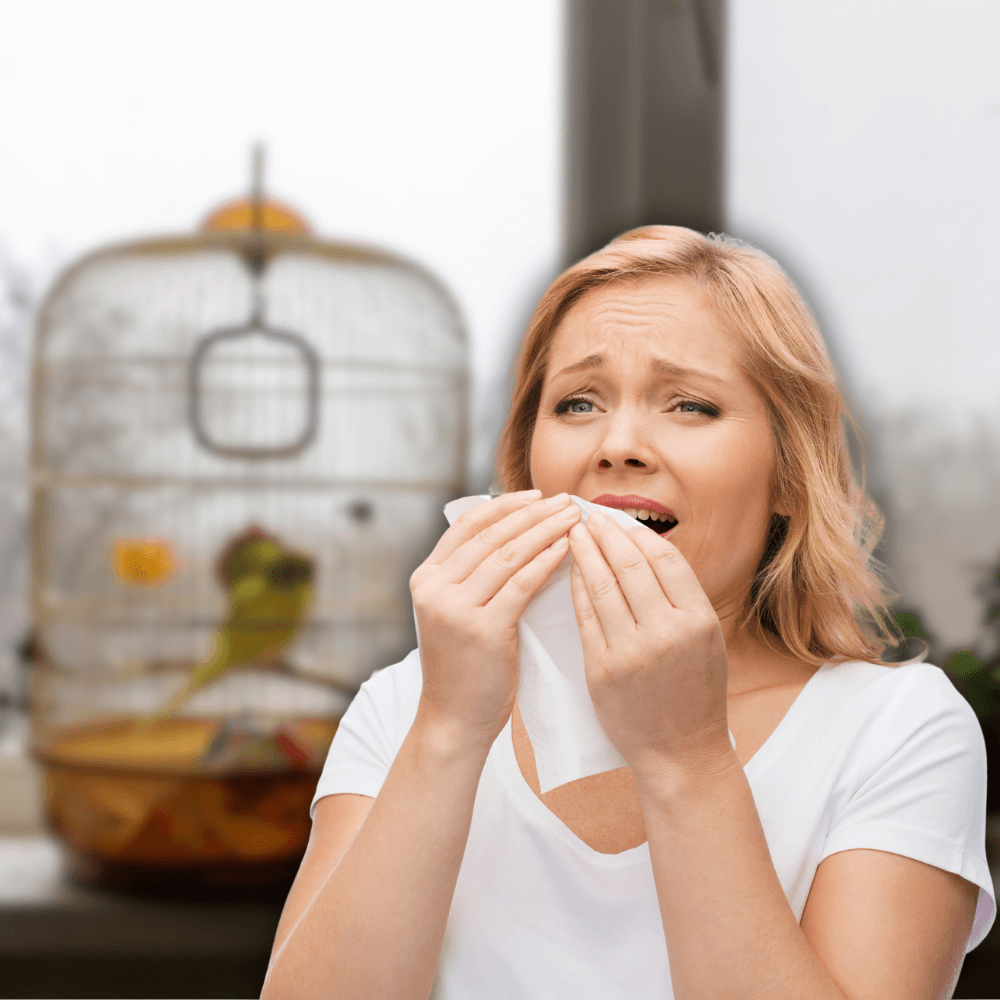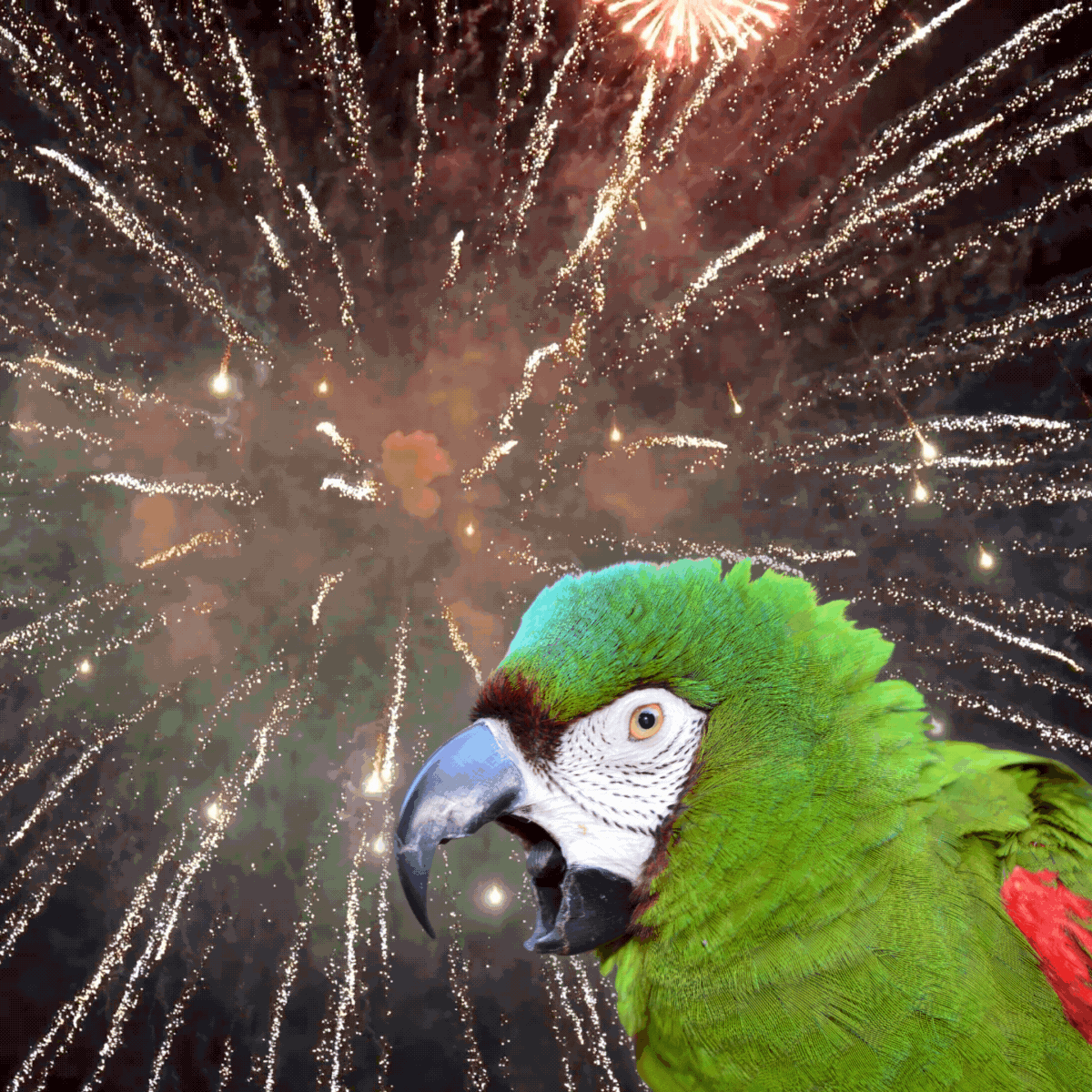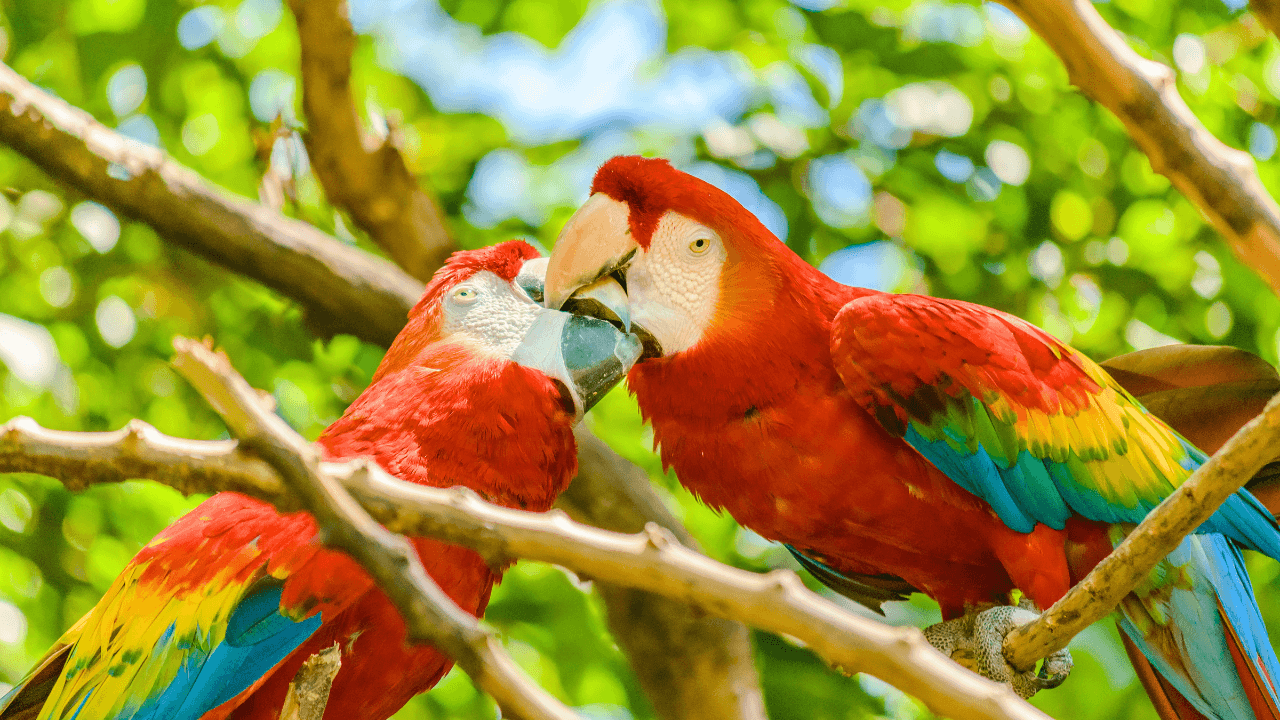Revised June 14, 2024
Table of Contents
- Understanding Bird Allergies
- Bird Dander Allergy
- Birds and Lung Disease
- Managing Bird Allergies with Environmental Control
- Choosing Bird Species for Allergy Sufferers
- 12 Tips To Reduce The Effects Of Bird Allergies
- Test Your Knowledge!
As a person with daily allergy problems, my physician suggested that I might have bird allergies. He informed me that birds are the number one pet-related allergy. The culprit of my sneezing and recurrent sinusitis - my 4 pet birds!
I've a Moluccan Cockatoo, two African Grey parrots, and a Green Cheek Conure. There is a lot of white, powdery dust at my house!
As of January 2024, Forbes Advisor says that 6.1 million households in the U.S. have pet birds. This is a drop from 2017, when a survey showed 20.6 million homes had birds. According to the American Pet Products Association's (APPA) 2021-2022 survey, 8% of households, or about 5.7 million homes, had pet birds. On average, each of these households had around 2.5 birds.
The information provided is for educational purposes only. For medical advice, please consult a healthcare professional. If you are experiencing breathing problems, seek immediate medical attention.
Understanding Bird Allergies
Causes of Bird Allergies
Bird allergies are often caused by bird dander, which includes tiny flakes of skin, the keratin sheath from new feathers, and broken feather barbs. These particles can get into the air and be inhaled, causing symptoms like sneezing, coughing, and itchy eyes. Feathers and bird droppings can also contribute to allergic reactions in some people.
Another cause of bird allergies is bird saliva, which spreads when birds preen their feathers. Some people are sensitive to proteins found in bird saliva and droppings. Keeping the bird’s living area clean and well-ventilated can help reduce these allergens and make it easier to live with your feathered friend.
Common Symptoms of Bird Allergies
Common symptoms of bird allergies include sneezing, coughing, itchy or watery eyes, and a runny or stuffy nose. Some people might also experience skin rashes or hives if they come into direct contact with bird dander or feathers. These symptoms are similar to those caused by other common allergens like pollen, dust mites, and pet dander.
One difference with bird allergies is that they can sometimes lead to more severe respiratory issues, such as wheezing or difficulty breathing, especially in people with asthma. Additionally, prolonged exposure to bird allergens can cause hypersensitivity pneumonitis, a condition that affects the lungs. Overall, bird allergy symptoms can be very similar to other allergies, but they can also have unique complications related to respiratory health.
Differences from Other Allergies
Bird allergies differ from other allergies primarily because they can lead to more severe respiratory issues. While symptoms like sneezing, coughing, and itchy eyes are common in all allergies, bird allergies can cause conditions like hypersensitivity pneumonitis, which affects the lungs. This is a more serious reaction that is less common with other allergens like pollen or dust mites. Additionally, proteins in bird dander, feathers, and droppings can cause unique allergic reactions. We will explore the connection between birds and lung disease in more detail later in this post.
Bird Dander Allergy
What is Bird Dander?
Bird dander is made up of tiny flakes of skin, the keratin sheath from new feathers, and broken feather barbs. Unlike fur-bearing pets like cats and dogs, birds shed dander as part of their natural feather growth and maintenance process. This dander can easily become airborne, leading to allergic reactions in sensitive individuals. While cats and dogs shed fur and dander, bird dander is unique because it includes feather particles and can be more pervasive in the air, often causing more intense respiratory symptoms in those who are allergic.
Bird dander allergies often cause common allergy symptoms like sneezing, coughing, and itchy or watery eyes. However, bird dander can also trigger unique respiratory symptoms such as wheezing and shortness of breath. For some individuals, bird dander can exacerbate asthma, leading to more frequent and severe attacks. These distinct respiratory reactions set bird dander allergies apart from other pet allergies.
Birds and Lung Disease
Overview of Bird-Related Lung Diseases
Lung diseases related to bird exposure, such as Hypersensitivity Pneumonitis (HP) and Bird Fancier's Lung, are serious conditions that can affect bird owners. These diseases occur when the immune system reacts to inhaled bird proteins found in feathers, droppings, and dander, causing inflammation in the lungs. Symptoms can include coughing, shortness of breath, and fatigue, and if left untreated, they can lead to chronic lung problems.
Hypersensitivity Pneumonitis (HP) is not very common, but it is a big concern for those who can get it. A study by Barrera et al. (2018) found that bird-related HP can affect up to 20% of people who are around birds a lot. This includes bird breeders, pet owners, and poultry workers.
Another study by Hanak et al. (2015) shows how important it is to diagnose and treat HP early. This can help prevent long-term damage. Bird owners should know about these risks and take steps to reduce exposure to bird allergens.
Hypersensitivity Pneumonitis and Bird Fancier's Lung
Lung diseases related to bird exposure, such as Bird Fancier's Lung and certain cases of Hypersensitivity Pneumonitis (HP), are serious conditions that can affect bird owners. These diseases occur when the immune system reacts to inhaled bird proteins found in feathers, droppings, and dander, causing inflammation in the lungs. Symptoms can include coughing, shortness of breath, and fatigue, and if left untreated, they can lead to chronic lung problems.
According to Dr. Caleb Hsieh and Chief Editor John J. Oppenheimer (2020), the Centers for Disease Control and Prevention (CDC) and the Work-Related Lung Disease Surveillance System (eWoRLD) track the morbidity and mortality of hypersensitivity pneumonitis in the United States.
The severity of HP can vary widely based on the type, duration, and intensity of exposure. Genetic factors can also play a role. In the early stages, HP symptoms may resemble the flu, with fevers, chills, and a dry cough, which usually resolve once exposure is removed. However, continuous or repeated exposure can lead to more severe symptoms like a persistent cough, shortness of breath, weight loss, and fatigue.
Prevention and Treatment
Ventilation: Keep your home well-ventilated and use air purifiers with HEPA filters to catch airborne particles like bird dander.
Regular Cleaning: Clean cages, perches, and surrounding areas frequently to minimize feathers, droppings, and dander. Use a vacuum cleaner with a HEPA filter to help reduce dust and dander.
Protective Gear: Wear masks and gloves when cleaning bird cages or handling birds to reduce direct exposure to allergens.
# of Birds: Fewer birds mean less dander and droppings, which lowers the risk of lung issues.
Bird-Free Zones: Create bird-free zones in your home, especially in areas where you spend a lot of time, like bedrooms, to limit exposure to allergens.
Treatment
If you develop symptoms of bird lung disease, it's important to see a doctor. Here are some common treatments:
Avoid Exposure: The first step is to avoid more exposure to bird allergens. In severe cases, this might mean finding new homes for your birds.
Corticosteroids: These help reduce lung inflammation and manage symptoms.
Bronchodilators: These can help open airways and make breathing easier.
Supportive Care
Oxygen Therapy: In severe cases, oxygen therapy can assist with breathing.
Pulmonary Rehabilitation: Exercises and education on lung health can improve lung function and overall health.
By taking these steps to prevent and treat bird lung disease, you can enjoy your feathered friends while keeping your lungs healthy.
Managing Bird Allergies with Environmental Control
Importance of Air Purifiers and Ventilation
Good air quality is crucial for both bird owners and their feathered friends. Air purifiers play a significant role in reducing airborne particles like bird dander, feathers, and droppings. These particles can cause allergic reactions and respiratory problems in both humans and birds. By using an air purifier, you can significantly decrease the amount of these irritants in the air, making the environment healthier for everyone. A popular and highly-rated brand is the Honeywell HPA300, known for its efficiency in capturing airborne particles and its ability to cover large rooms.
Ventilation is another key factor in maintaining good air quality. Proper ventilation helps to remove stale air and replace it with fresh air, reducing the concentration of indoor pollutants. This is especially important in areas where birds are kept, as it helps to dissipate any accumulated dander and odors.
Opening windows, using exhaust fans, and maintaining clean air ducts are simple yet effective ways to improve ventilation in your home. Together with an air purifier, good ventilation ensures a healthier living space for both you and your birds.
Daily Cleaning Routine

-
Change Cage Liners: Replace the cage liners daily to prevent the buildup of droppings and dander. This helps keep the cage clean and reduces odors.
-
Clean Food and Water Dishes: Wash and refill food and water dishes with fresh supplies every day. This ensures your bird has clean, uncontaminated food and water.
-
Wipe Down Surfaces: Use a damp cloth to wipe down the cage bars, perches, and toys. This removes any accumulated dust, dander, and droppings.
-
Vacuum or Sweep the Area: Clean the area around the cage to pick up any fallen feathers, seeds, or debris. This helps maintain a clean environment and reduces airborne particles.
-
Check Ventilation: Open windows or use exhaust fans to ensure proper air circulation. This helps to reduce the concentration of indoor pollutants and keep the air fresh.
By incorporating these simple tasks into your daily routine, you can maintain a clean and healthy environment for both you and your bird.
Safe, Natural Cleaning Products for Bird Owners
-
White Vinegar: White vinegar is a powerful, natural cleaner that can be used to disinfect bird cages and accessories. It effectively removes grime, bacteria, and odors without releasing harmful fumes. Mix equal parts white vinegar and water in a spray bottle for an easy, non-toxic cleaning solution.
-
Baking Soda: Baking soda is a gentle abrasive that can be used to scrub away tough stains and deodorize surfaces. It’s safe for birds and can be sprinkled directly on surfaces or mixed with water to form a paste. Use it to clean perches, toys, and the cage floor.
-
Lemon Juice: Lemon juice has natural antibacterial and antifungal properties. It can be used to clean and freshen up bird cages and accessories. Mix lemon juice with water for a safe, fragrant cleaner that leaves no harmful residues.
-
Castile Soap: Castile soap is a vegetable-based soap that is free of synthetic chemicals. It’s safe for birds and can be diluted with water to clean cages, perches, and toys. Look for unscented varieties to avoid any potential irritation.
-
Hydrogen Peroxide: Hydrogen peroxide is a safe and effective disinfectant that can be used to clean bird cages. It breaks down into water and oxygen, leaving no harmful residues. Use a 3% solution and apply it directly to surfaces or dilute it with water for regular cleaning.
By using these natural cleaning products, you can maintain a safe and healthy environment for your bird without exposing them to harmful fumes or chemicals.
Choosing Bird Species for Allergy Sufferers
Hypoallergenic and Low-Dander Birds
| Low Dander Birds | Powder Down/Dusty Birds |
|---|---|
|
Parakeets (Budgies) Small, social birds with minimal dander. |
Cockatiels Produce fine powder from feathers. |
|
Canaries Sing beautifully and have low dander. |
African Grey Parrots Known for significant powder production. |
|
Finches Tiny, active birds that produce little dander. |
Cockatoos High levels of powder down. |
|
Lovebirds Small parrots with minimal dander. |
Amazon Parrots Moderate dust production compared to cockatoos and greys. |
|
Pionus Parrots Gentle birds with less dust and dander. |
Moluccan Cockatoos High levels of powder down. |
Selecting and Caring for Low-Allergen Birds
Choosing a low-allergen bird can make a significant difference for allergy sufferers. When selecting a bird, consider species known for producing less dander, such as parakeets (budgies), canaries, finches, lovebirds, and pionus parrots. These birds tend to shed fewer particles that can trigger allergies, making them more suitable for those sensitive to allergens. It's also helpful to spend some time with the bird before bringing it home to see if any allergic reactions occur.
Caring for low-allergen birds involves maintaining a clean and well-ventilated environment. Regularly clean the bird's cage, toys, and perches to minimize the buildup of dander and dust. Use an air purifier with a HEPA filter to reduce airborne particles and ensure proper ventilation in the bird's living area. Bathing your bird frequently can also help reduce the amount of dander they produce. By choosing the right bird and maintaining good hygiene, you can enjoy the companionship of your feathered friend while keeping allergy symptoms at bay.
12 Tips To Reduce the Effects of Bird Allergies
- Use air purification devices to reduce allergens and eliminate odors.
- Wash your hands after handling your bird and before touching your face or eyes.
- Create allergy-free areas in your home by restricting birds from certain rooms in your home, especially the bedrooms.
- Reduce the amount of carpet in your home, especially in bedrooms & sitting rooms.
- Use allergy-resistant covers on mattresses and pillows.
- Keep your house well-ventilated.
- Change the cage paper daily. Or better yet, try Anti-microbial Cage Paper.
- Use a face mask when changing cage liners.
- Consider purchasing a Floor Steamer hard surface floor cleaner to manage dander.
- Change your furnace filter every 3-4 weeks.
- Replace drapes with vertical blinds that don't hold the dust.
- Try a quality bird spray like UnRuffledRx Aloe Vera Spray to reduce dander and dust and manage your parrot allergy
Test Your Knowledge!
Quiz: Test Your Knowledge on Bird Allergies and Care
In conclusion...
Bird allergies and birds and lung disease are serious concerns for many bird owners, but with the right strategies, you can manage these issues effectively. By choosing low-dander bird species, maintaining a clean and well-ventilated environment, and using natural cleaning products, you can significantly reduce exposure to allergens. Regularly cleaning your bird's cage and surrounding areas, using air purifiers, and being mindful of proper ventilation are key steps to ensure a healthy home for both you and your feathered friends. Remember, the well-being of both you and your birds depends on a clean, allergen-free environment. With these tips in mind, you can enjoy the companionship of your birds while keeping everyone healthy.
Related Posts:
Daily, Weekly and Monthly Bird Care Plan: Printable Bird Care Guide
Spring Serenity: Bird Care Strategies for a Calm and Happy Feathered Friend
Choosing Your First Bird – 4 Popular First Birds
Managing Cockatoo Dander and Cockatiel Dust
References:
Barrera, L.; Mendoza, F.; Zuñiga, J.; Estrada, A.; Zamora, A.C.; Melendro, E.I.; Ramírez, R.; Pardo, A.; Selman, M. Functional Diversity of T-Cell Subpopulations in Subacute and Chronic Hypersensitivity Pneumonitis. Am. J. Respir. Crit. Care Med. 2008, 177, 44–55.
Barrera, G., Zuluaga, G., Restrepo, J., & Pineda, A. (2018). Hypersensitivity pneumonitis in bird breeders: Epidemiological study. Journal of Occupational and Environmental Medicine, 60(6), 450-457.
Hanak, V., Kalra, S., Aksamit, T. R., & Hartman, T. E. (2015). Hypersensitivity pneumonitis: Insights from a review of 200 patients. Chest, 128(3), 1116-1123.
Link to this blog
Burroughs, D. (2024, June 15). 12 must-know tips if you're allergic to birds. BirdSupplies.com. Retrieved from https://birdsupplies.com/blogs/news/12-must-know-tips-if-youre-allergic-to-birds
Diane Burroughs, LCSW is a licensed psychotherapist trained in ABA therapy techniques. She specializes in avian anxiety disorders and is certified in Nutrition For Mental Health. Diane has written a number of bird behavior books and she offers behavior consultations. She's developed a range of UnRuffledRx Science-backed Parrot Wellness Supplies.
Diane's products have been featured in the Journal of Avian Medicine and Surgery and at Exoticscon, a conference for exotic pet veterinarians. Her bird collars & supplements are stocked in avian vet clinics and bird stores throughout the US. With over 30 years in the field of behavior, Diane has created thousands of successful individualized behavior plans that help pets thrive.
TAGS: #BirdAllergies #BirdsAndLungDisease
SHARING IS CARING! PLEASE SHARE ON YOUR FAVORITE SOCIAL MEDIA NOW!





